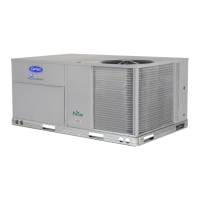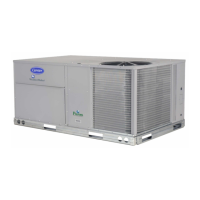36
6. The first schedule is now complete. If a second schedule is
needed, such as for weekends or holidays, scroll down and
repeat the entire procedure for period 2 (PER.2). If addi-
tional schedules are needed, repeat the process for as many
as are needed. Eight schedules are provided.
SERVICE TEST
General
The units are equipped with a Service Test feature, which is in-
tended to allow a service person to force the unit into different
modes of operation. To use this feature, enter the Service Test
category on the local display and place the unit into the test
mode by changing Service Test
TEST from OFF to ON. The
display will prompt for the password before allowing any
change. The default password is 1111. Once the unit enters the
Service Test mode, the unit will shut down all current modes.
TEST
The TEST command turns the unit off (hard stop) and allows
the unit to be put in a manual control mode.
STOP
The STOP command completely disables the unit (all outputs turn
off immediately). Once in this mode, nothing can override the unit
to turn it on. The controller will ignore all inputs and commands.
S.STP
Setting Soft Stop to YES turns the unit off in an orderly way,
honoring any time guards currently in effect.
FAN.F
By turning the FAN FORCE on, the supply fan is turned on and
will operate as it normally would, controlling duct static pres-
sure on VAV applications or just energizing the fan on CV ap-
plications. To remove the force, press ENTER and then press
the UP and DOWN arrows simultaneously.
The remaining categories: INDP, FANS, AC.T.C, HMZR,
COOL, and HEAT are sub-menus with separate items and
functions. See Table 29.
Service Test Mode Logic
Operation in the Service Test mode is sub-menu specific except
for the INDP sub-menu. Leaving the sub-menu while a test is be-
ing performed and attempting to start a different test in the new
sub-menu will cause the previous test to terminate. When this hap-
pens, the new request will be delayed for 5 seconds. For example,
if compressors were turned on under the COOL sub-menu, any at-
tempt to turn on heating stages within the HEAT sub-menu would
immediately turn off the compressors and 5 seconds later the con-
troller would honor the requested heat stages.
However, it is important to note that the user can leave a Ser-
vice Test mode to view any of the local display menus (Run
Status, Temperatures, Pressures, Setpoints, Inputs, Outputs,
Configuration, Time Clock, Operating Modes, and Alarms)
and the control will remain in the Service Test mode.
Independent Outputs
The INDP sub-menu items can be turned on and off regardless
of the other category states. For example, the humidifier relay
or remote alarm/auxiliary relay can be forced on in the INDP
sub-menu and will remain on if compressor stages were re-
quested in the COOL sub-menu.
Fans
Upon entering the FANS sub-menu, the user will be able to en-
act either a manual or automatic style of test operation. The
first item in the sub-menu, Fan Test Mode Automatic (Service
Test
FANS
F. M O D ), allows the fan and the configured
static pressure or building pressure control to begin as in the
application run mode. During this automatic mode, it is possi-
ble to manually control condenser fans 1 to 4.
If Fan Test Mode Automatic (Service Test
FANS
F. M O D ), is
set to NO, then the user will have individual control over duct stat-
ic pressure (VFD speed), building pressure and condenser fan con-
trol. Additionally, the controller will protect the system from de-
veloping too much static pressure. If the static pressure during
manual control rises above 3 in. wg or if the Static Pressure Set
Point (Setpoints
SPSP) is greater than 2.5 in. wg and static pres-
sure is 0.5 in. wg higher than SPSP, then all options in the FANS
menu will be cleared back to their default OFF states.
The power exhaust dampers can be energized individually or to-
gether and their damper positions can be forced to any position.
Actuators
In the AC.T.C sub-menu, it will be possible to control and cali-
brate actuators. Calibration is a mode in which the actuator
moves from 0% to the point at which the actuator stalls, and it
will then use this angular travel range as its “control angle”. It
will also be possible to view the “control angle” adopted by the
actuator after a calibration.
Within this sub-menu, the user may calibrate and control econ-
omizer actuators 1 and 2, the building pressure actuators 1
and 2, the hydronic heating coil actuator, and the humidifier
steam valve control actuator.
NOTE: Once a calibration has been started, the user cannot exit
test mode or select any other test mode operation until the calibra-
tion is complete.

